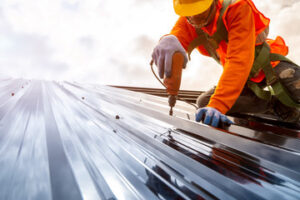When purchasing a new commercial roof, there are three important criteria to consider. Cost, durability, and energy efficiency are important, but you’ll want to keep these three criteria in mind while deciding on a new roof for your business. Many roofing systems are cheaper to purchase, but may not be as energy-efficient as you’d like. These factors should also be considered when comparing the costs of various Roofing systems, especially when choosing one for your business.

Your roof’s material should be compatible with your building’s climatic zone and structure. You also want to consider foot traffic. A low-sloped roof will be more difficult to maintain and will require a different roofing material. It will also likely be more vulnerable to water intrusion and storm damage, compromising the structural integrity of the building and damaging stock and equipment. However, a low-sloped roof can help protect structural integrity and keep utility bills low.
Polyisocyanurate is a great insulation option for commercial roofs. This material is both affordable and energy-efficient. It can last for decades and provides superior fire resistance. This type of roofing also has a higher R-value than any other insulation product available. Bitumen-based ply sheets and organic or fiberglass reinforcements are used for built-up roofing systems. Depending on the thickness of the layers, built-up roofing can last anywhere from 15 to 30 years.
Another important consideration is the roof’s load-bearing capacity. The weight that a commercial roofing system can support depends on the structure of the building and its use. In some commercial buildings, heavy equipment is housed on the roof. If your building needs to handle the weight of this equipment, a heavier material might be better. So be sure to consider load-bearing capacity when selecting a new commercial roofing system. If the roof can withstand heavy equipment, it might be a better option to choose a metal roof over asphalt.
Metal roofing is an excellent choice for commercial buildings because it is resistant to fire, improves HVAC performance, and is recyclable. Typical commercial roof covers are made of layers of materials such as asphalt or modified bitumen. The more layers of a material, the stronger it will be. You should be sure to consult with a professional when considering the best type of roofing for your building. If you’re not sure, you can always hire a roofing contractor.
Another type of commercial roofing system is the thermoplastic polyolefin (TPO) roof. These roofs are more durable and economical than EPDM or PVC. Moreover, they’re also resistant to heat and are often white. And, unlike traditional materials like EPDM, they don’t need pressure washing. The thermoplastic polyolefin material is also very lightweight. This makes them an excellent choice for businesses with ventilation systems or oil and fat emissions.
There are many advantages of single-ply commercial roofing. Besides cost, it also has lower seams and fewer gaps. It can last up to 20 years. And because it doesn’t require heated materials, it is safer to install. These roofing systems are also more durable and last for a longer time. And they don’t create any odor or invasive disturbance. You’ll be able to enjoy peace of mind knowing that you’re getting the best deal for your money.
While there are some differences between residential and commercial roofing, they share the same basic purpose of protecting the structure from the elements. While residential roofing uses materials such as clay tiles and corrugated iron, commercial roofing systems typically utilize metal, asphalt, and concrete. Since these materials are heavier and require more maintenance, they’re more expensive to install than residential roofing. You’ll likely want a company with a good reputation for installing roofs for commercial buildings.
EPDM and TPO are two popular types of commercial roofing materials, and each has its pros and cons. They are both a bit difficult to install, but the main difference is that EPDM is easier to apply than BUR. When you install EPDM roofing, the material comes in rolls from the manufacturer. After the layers are bonded, the seams are sealed with a special seam adhesive. This seam adhesive creates a water-tight seal. Unlike metal roofing, EPDM and TPO roofing are easier to replace than BUR or metal roofing.
EPDM (ethylene propylene diene monomer) is another durable and versatile roofing material. It’s best used on low-slope buildings. EPDM is typically white or black. There are several different thickness levels available, from 0.5 mm to a couple of inches. Polyvinyl chloride (PVC) is a lightweight and durable material that is perfect for second-generation applications. TPO is also extremely reflective and highly resistant to most chemicals.
